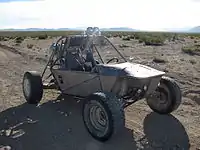Dune buggy
A dune buggy — also known as a beach buggy — is a recreational motor vehicle with large wheels, and wide tires, designed for use on sand dunes, beaches, roads or desert recreation.



The design is usually a roofless vehicle with a rear-mounted engine. A dune buggy can be created by modifying an existing vehicle or custom-building a new vehicle.
Design
Dune buggies are typically created by modifying an existing road vehicle,[1] while sandrails are built from the ground up as a custom vehicle.
Beetle-based buggies
For dune buggies built on the chassis of an existing vehicle, the Volkswagen Beetle was commonly used as the basis for the buggy.[2] The model is nicknamed Bug, therefore the term "buggy". The Beetle platform chassis was used because the rear engine layout improves traction,[3] the air-cooled engine[4][5] avoids the complexities and failure points associated with a water-cooled engine, the front suspension was considered cheap and robust[6] and the spare parts from Volkswagen were cheap and readily available.[7] Dune buggies with glass-reinforced plastic (fiberglass) bodies come in many shapes and sizes.
The original fiberglass dune buggy was the 1964 "Meyers Manx" built by Bruce Meyers.[2] Bruce Meyers designed his fiberglass bodies as a "kit-car", using the Volkswagen Beetle chassis.[3] Many other companies worldwide have copied the original fiberglass dune buggy.[3] These types of dune buggies are known as "clones".[2]
Sandrail


A sandrail is a lightweight vehicle similar to a dune buggy, but designed specifically for operation on open sand.
Sandrails are usually built as a spaceframe by welding steel tubes together.[8][9] The name sandrail is due to the frame "rails" present. The advantage of this method is that the fabricator can change fundamental parts of the vehicle (usually the suspension and addition of a built-in roll cage). Sandrails, as per dune buggies, often have the engine located behind the driver. Sizes can vary from a small-engine one-seat size to four-seat vehicles with eight or more cylinders.[10]
A similar, more recent generation of off-road vehicle, often similar in appearance to a sandrail, but designed for a different use, is the "off road go-kart". The difference may be little more than fitting all-terrain tires instead of sand tires and the much smaller size of the engine.
Military use


Because of the advantages a buggy can afford on some terrain, they are also used by the military.[11]
The buggies built for the United States military used to be called Desert Patrol Vehicles (DPV) or Fast Attack Vehicles (FAV), and with the latest improvements are known as Light Strike Vehicles (LSV). They are used by United States Navy SEALs, the SAS, and other forces. Among the dune buggies used by the United States military is the Chenowth Advanced Light Strike Vehicle.[12] The US Border Patrol also uses this (although it is not a military organization).
In the United Kingdom, the SAS have used cut-down, light-weight all terrain vehicles for secret special operations "behind the lines" since early in World War II.[13] A buggy was used by the British Special Air Services (SAS) forces during the Gulf War. A long-range special desert operations vehicle was developed in 1992 and nicknamed "pink panthers" because of their color,[14] but these were only modified Land Rovers.[15][16]
See also
References
- "Dune Buggy History". www.dunebuggyarchives.com. Retrieved 13 April 2018.
- "Meyers Manx, the Beetle-based cure for summertime blues". www.bbc.com. Retrieved 13 April 2018.
- "This man invented the dune buggy". www.topgear.com. Retrieved 13 April 2018.
- "How Bruce Meyers Turned the VW Beetle Into the World's Most Famous Dune Buggy". www.roadandtrack.com. Retrieved 13 April 2018.
- "Air-Cooled VW Racers to Compete in the Texas Desert Racing Association Twin 150s Desert Race". www.dunebuggywarehouse.com. Retrieved 13 April 2018.
- "Dune Buggy". www.buildyourownracecar.com. Retrieved 13 April 2018.
- "The History of VW Sand Rail Vehicles". www.insideyourrv.com. Retrieved 14 April 2018.
- "How they are built sandrails". www.marksdreamshack.com. Retrieved 14 April 2018.
- "Twister Sand Cars". www.thebuggyshop.50megs.com. Retrieved 14 April 2018.
- "Buying a Sandrail 101". www.acmecarco.com. Retrieved 14 April 2018.
- "The U.S. Army Had a Whole Battalion of Armed Dune Buggies". www.medium.com. Retrieved 17 April 2018.
- "Advanced Light Strike Vehicle". Specialoperations.com. 2000. Archived from the original on 25 May 2011. Retrieved 25 October 2020.
- "This Is What It's Like To Hoon An Ex-SAS Military Dune Buggy". www.petrolicious.com. Retrieved 17 April 2018.
- Watson, Bruce Allen (2006). Desert Battles: From Napoleon to the Gulf War. Stackpole Books. p. 200. ISBN 9780811733809. Retrieved 16 February 2018.
- "Series IIA 'Pink Panthe'". World history. 2 July 2015. Retrieved 16 February 2018.
- Smallwood, Karl (16 June 2014). "The SAS Used to Drive Bright Pink Vehicles During the Gulf War". Fact Fiend. Retrieved 16 February 2018.
External links
| Wikimedia Commons has media related to Dune buggies. |